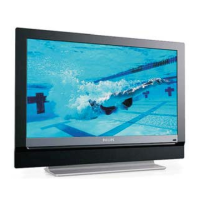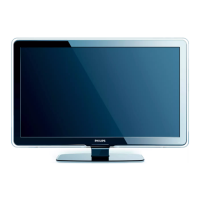Do you have a question about the Philips 32PFL7605H/12 and is the answer not in the manual?
Provides technical details, product information, user manuals, FAQs, and software/drivers.
Essential safety regulations to follow during repair and after completion.
Critical warnings regarding ESD, high voltage, and tool usage during repair.
Step-by-step instructions for removing rear covers, speakers, and panels for various stylings.
Guidance on using test patterns and ICs for determining defective parts.
Overview of Service Default Mode (SDM), Service Alignment Mode (SAM), and Customer Service Mode (CSM).
Explanation of the stepwise start-up process and transition diagram for error detection.
Details on how to read and interpret error codes, including Layer 1 and Layer 2 errors.
Procedure for activating and interpreting blinking LED errors for fault diagnosis.
Information about software and hardware protections that trigger during operation.
Practical advice for diagnosing issues, logging information, and handling specific components.
Instructions for upgrading main software, standby software, and using USB for updates.
Required voltage supply, warm-up time, and test probe specifications for alignments.
Procedures for aligning White Point, Ambilight, and TCON settings via SAM.
Details on setting dealer options, service options, and option numbers.
Crucial steps for resetting the NVM on a repaired SSB and programming type numbers.
Instructions for loading main TV software onto a service SSB when no picture is available.
Features of the PNX85500 processor for video decoding, picture processing, and audio.
Internal block diagram and pin configuration for the PNX85500 IC.
Block diagram and pin configuration for the Class D Audio Amplifier IC.
Wiring diagrams for various TV models showing component connections.
Illustrates the video signal flow and processing within the TV.
Shows the audio signal path and processing within the TV.
Provides technical details, product information, user manuals, FAQs, and software/drivers.
Essential safety regulations to follow during repair and after completion.
Critical warnings regarding ESD, high voltage, and tool usage during repair.
Step-by-step instructions for removing rear covers, speakers, and panels for various stylings.
Guidance on using test patterns and ICs for determining defective parts.
Overview of Service Default Mode (SDM), Service Alignment Mode (SAM), and Customer Service Mode (CSM).
Explanation of the stepwise start-up process and transition diagram for error detection.
Details on how to read and interpret error codes, including Layer 1 and Layer 2 errors.
Procedure for activating and interpreting blinking LED errors for fault diagnosis.
Information about software and hardware protections that trigger during operation.
Practical advice for diagnosing issues, logging information, and handling specific components.
Instructions for upgrading main software, standby software, and using USB for updates.
Required voltage supply, warm-up time, and test probe specifications for alignments.
Procedures for aligning White Point, Ambilight, and TCON settings via SAM.
Details on setting dealer options, service options, and option numbers.
Crucial steps for resetting the NVM on a repaired SSB and programming type numbers.
Instructions for loading main TV software onto a service SSB when no picture is available.
Features of the PNX85500 processor for video decoding, picture processing, and audio.
Internal block diagram and pin configuration for the PNX85500 IC.
Block diagram and pin configuration for the Class D Audio Amplifier IC.
Wiring diagrams for various TV models showing component connections.
Illustrates the video signal flow and processing within the TV.
Shows the audio signal path and processing within the TV.












